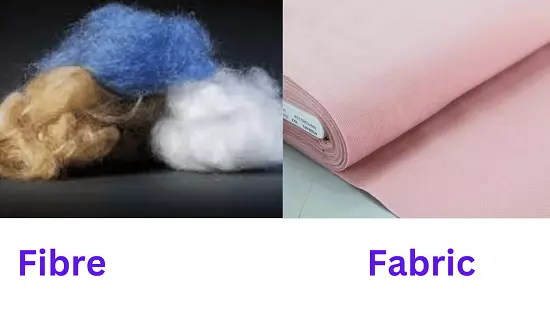Fibre And Fabric are two different things, so there are a lot of differences between these two. One is the very initial process of textile manufacturing and another is the ready raw material of Garments manufacturing/ clothing. Many more things to differentiate between these two. Let’s find out below all the differences between Fibre And Fabric.
Fibre
Fibre is the basic raw material in order to make fabric. Fibres are modified to yarn in the spinning process. Yarn is converted into fabric through the weaving and knitting process. Fibre examples are Cotton Fibre, Wool fibre, Polyester Fibre, Nylon Fibre, etc.
Fabric
Fabric is the ready raw material for the clothing process. The process of Fabric manufacturing is to get fibre first, then spun for yarn; and then weave, knit, and bond process for Fabric. All we have to cut and sew according to the pattern in order to get a cloth. Fabrics are 3 types; woven Fabric, Knit Fabric, and Nonwoven Fabric.

What are the Differences Between Fibre And Fabric?
| Category | Fibre | Fabric |
| Definition | Fibre is a Textile raw material that spun in the spinning to conver into yarn or thread | Fabric is a finished textile material that produced through weaving, knitting, crocheting, bonding, or felting fibers together. |
| Hierarchy | The raw material used to make Yarn and then Yarn use to make Fabric. | The finished textile product used from Yarn. |
| Origin | Two types by Origin; Natural and synthetic (regenerated by chemical process) | can be a combination of synthetic and natural or pure. |
| Examples | Examples include cotton Fibre, wool Fiber, silk, Fibre etc | Examples include Satin Fabric, Canvas Fabric, Jersey Fabric, etc |
| Processing | Can be spun into yarn or thread | Can be woven, knitted, bonding into various textures and patterns |
| Production | Fibre is produced through natural processes such as growing cotton plants or raising sheep for wool. | Fabric production involves spinning the fibers into yarn and then weaving or knitting the yarn into fabric. |
| Properties | Fibers have different properties such as absorbency, strength, and elasticity. | The property of the fiber affects the properties of the fabric, such as how well it absorbs moisture or how stretchy it is. |
| Uses | Fibres are used to make Yarn or textile Materials | Fabrics are used primarily in clothing and home furnishings, but also in industrial and medical applications. |
| Durability | Fibres are generally less durable than fabrics despite they can withstand more wear and tear. | Fabrics made from natural fibers such as cotton and linen are more durable than those made from synthetic fibers such as polyester. |
| Cost | Fibres are generally cheaper than fabrics as they are the raw materials used to make the fabric. | However, the cost of fabric can depend on the type of fiber used, the quality of the yarn, and the type of fabric. |
Conclusion
Fibre And Fabric are different and they have different functions and processes. Fibre converted to Fabric at one stage but Fabric cannot be fibre again. So we can Fibre used to make fabric in textile manufacturing, and Fabric used for clothing and Fashion.
